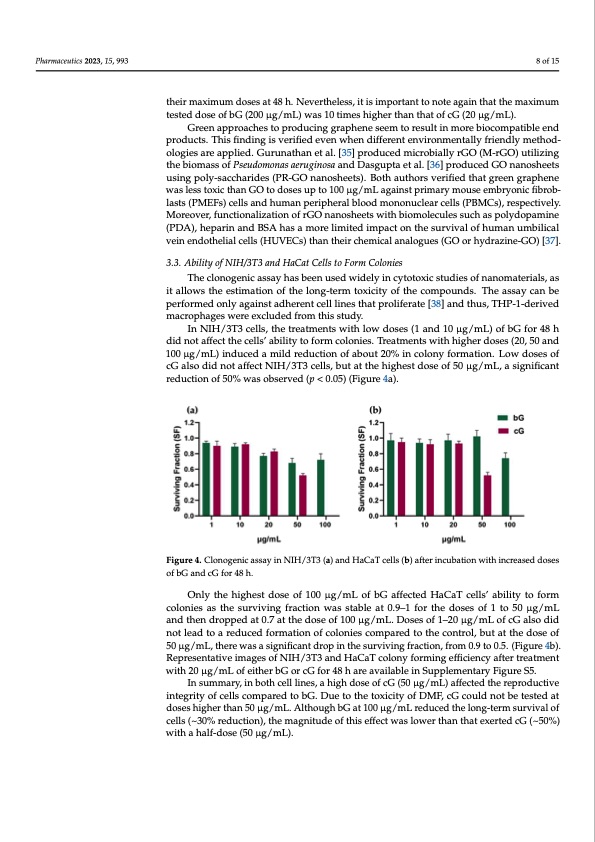
PDF Publication Title:
Text from PDF Page: 008
Pharmaceutics 2023, 15, 993 remained high, at 90% for both 24 h and 48 h (Figure 3e,f). Optical images of NIH/3T3, HaCaT and THP-1 cells (untreated and treated with 20 μg/mL of either bG or cG for 24 h) stained with crystal violet can be found in Supplementary Figure S4. Overall, apart from THP-1 macrophages, where no toxicity was reported, bot8hofb1G5 and cG acted similarly in NIH/3T3 and HaCaT cells, resulting in a 50% decline in viability at their maximum doses at 48 h. Nevertheless, it is important to note again that the maxi- mum tested dose of bG (200 μg/mL) was 10 times higher than that of cG (20 μg/mL). their maximum doses at 48 h. Nevertheless, it is important to note again that the maximum Green approaches to producing graphene seem to result in more biocompatible end tested dose of bG (200 μg/mL) was 10 times higher than that of cG (20 μg/mL). products. This finding is verified even when different environmentally friendly method- Green approaches to producing graphene seem to result in more biocompatible end ologies are applied. Gurunathan et al. [35] produced microbially rGO (M-rGO) utilizing products. This finding is verified even when different environmentally friendly method- the biomass of Pseudomonas aeruginosa and Dasgupta et al. [36] produced GO nanosheets ologies are applied. Gurunathan et al. [35] produced microbially rGO (M-rGO) utilizing using poly-saccharides (PR-GO nanosheets). Both authors verified that green graphene the biomass of Pseudomonas aeruginosa and Dasgupta et al. [36] produced GO nanosheets was less toxic than GO to doses up to 100 μg/mL against primary mouse embryonic fibro- using poly-saccharides (PR-GO nanosheets). Both authors verified that green graphene wblastlses(sPtMoxEicFsth)acnelGlsOatnoddhousemsaunpptoer1i0p0hμerga/lmbLloaogdaimnsotnpornimucalreyarmcoeullsse(ePmBbMryCosn),icrfiesbproebc- ltaivstesly(P.MoErFeso)vcerl,lsfuancdtihounmalaiznatpieornipohferrGaOlbnloaondosmheoentosnwuictlheabriocmellosle(PcuBlMesCssu)c,hreassppecotliyvdeloy-. Mpaomreionvee(rP,DfuAnc),tihoenpaalirziantiaondofBrSGAOhnaasnaosmhoeeretslwimitihtebdioimpoalecctuolenstshuechsuarsvpivoalyldoofphauminane (uPmDbAil)i,chaelpvaerinineannddotBhSeAliahlacselalsm(HorUeVliEmCiste)dthiamnptahcetironchtehmeiscuarlvainvaloogfuheusm(GaOnuomrhbyildicral- vzeinine-eGnOdo)t[h3e7l]i.al cells (HUVECs) than their chemical analogues (GO or hydrazine-GO) [37]. 3.3. Ability of NIH/3T3 and HaCat Cells to Form Colonies 3.3. Ability of NIH/3T3 and HaCat Cells to Form Colonies The clonogenic assay has been used widely in cytotoxic studies of nanomaterials, as The clonogenic assay has been used widely in cytotoxic studies of nanomaterials, as it allows the estimation of the long-term toxicity of the compounds. The assay can be it allows the estimation of the long-term toxicity of the compounds. The assay can be per- performed only against adherent cell lines that proliferate [38] and thus, THP-1-derived formed only against adherent cell lines that proliferate [38] and thus, THP-1-derived mac- macrophages were excluded from this study. rophages were excluded from this study. In NIH/3T3 cells, the treatments with low doses (1 and 10 μg/mL) of bG for 48 h In NIH/3T3 cells, the treatments with low doses (1 and 10 μg/mL) of bG for 48 h did did not affect the cells’ ability to form colonies. Treatments with higher doses (20, 50 and not affect the cells’ ability to form colonies. Treatments with higher doses (20, 50 and 100 100 μg/mL) induced a mild reduction of about 20% in colony formation. Low doses of μg/mL) induced a mild reduction of about 20% in colony formation. Low doses of cG also cG also did not affect NIH/3T3 cells, but at the highest dose of 50 μg/mL, a significant did not affect NIH/3T3 cells, but at the highest dose of 50 μg/mL, a significant reduction reduction of 50% was observed (p < 0.05) (Figure 4a). of 50% was observed (p < 0.05) (Figure 4a). Figure 4. Clonogenic assay in NIH/3T3 (a) and HaCaT cells (b) after incubation with increased doses Figure 4. Clonogenic assay in NIH/3T3 (a) and HaCaT cells (b) after incubation with increased doses of bG and cG for 48 h. of bG and cG for 48 h. Onlythehiighessttddoosseeooff10100μgμ/gm/LmoLfboGfbaGffeacftfeedctHedaCHaaTCcaeTllsc’ealblsi’litaybitloitfyortmofcorlmo- cnoielosnaisesthaesstuhrevisvuinrvgivfriancgtiofrnacwtiaosnstwabaslesattab0l.9e–a1tf0o.r9t–h1efdoorstehseodfo1steos5o0fμ1gt/omL50anμdg/thmeLn adnrdoptphednadtr0o.p7paetdthaetd0.o7seatotfh1e0d0oμsge/mofL1.0D0oμsges/mofL1.–D20osμegs/mofL1o–2f0cGμga/lsmoLdiodfncoGtlaelasoddtoida nreodtulecaedftoramraetdiounceodfcfolromniaetsiocnomofpcaorelodntioesthceomcopnatroedl,btouthatetchoendtroosle,obfu5t0aμtgth/medLo,tsheeoref 5w0aμsga/smigLn,itfhicearnetwdarospaisnigtnhiefiscuanrvtidvrionpgifnratchteiosnu,rfvriovming0.9frtaoct0io.5n.,(Ffriogmur0e.94bto).0R.e5p. (rFeisgeunrteat4ibv)e. RimepargeseonftaNtiIvHe/i3mTa3gaensdofHNaCIHa/T3cTo3loanydfHoramCianTgceoflfoicnieynfcoyrmafitnegr terfefiactimenecnyt awftiethr t2r0eaμtgm/menLt with 20 μg/mL of either bG or cG for 48 h are available in Supplementary Figure S5. of either bG or cG for 48 h are available in Supplementary Figure S5. In summary, in both cell lines, a high dose of cG (50 μg/mL) affected the reproductive In summary, in both cell lines, a high dose of cG (50 μg/mL) affected the reproductive integrity of cells compared to bG. Due to the toxicity of DMF, cG could not be tested at integrity of cells compared to bG. Due to the toxicity of DMF, cG could not be tested at doses higher than 50 μg/mL. Although bG at 100 μg/mL reduced the long-term survival of cells (~30% reduction), the magnitude of this effect was lower than that exerted cG (~50%) with a half-dose (50 μg/mL).PDF Image | Green Exfoliation of Graphene

PDF Search Title:
Green Exfoliation of GrapheneOriginal File Name Searched:
pharmaceutics-15-00993.pdfDIY PDF Search: Google It | Yahoo | Bing
Salgenx Redox Flow Battery Technology: Power up your energy storage game with Salgenx Salt Water Battery. With its advanced technology, the flow battery provides reliable, scalable, and sustainable energy storage for utility-scale projects. Upgrade to a Salgenx flow battery today and take control of your energy future.
| CONTACT TEL: 608-238-6001 Email: greg@infinityturbine.com | RSS | AMP |